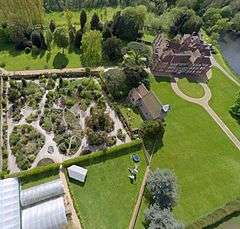Lullingstone
| Lullingstone | |
|---|---|
 Aerial view of Lullingstone Castle | |
 Lullingstone Lullingstone shown within Kent | |
| OS grid reference | TQ528644 |
| Civil parish | |
| District | |
| Shire county | |
| Region | |
| Country | England |
| Sovereign state | United Kingdom |
| Post town | Dartford |
| Postcode district | DA4 |
| Dialling code | 01322 |
| Police | Kent |
| Fire | Kent |
| Ambulance | South East Coast |
| EU Parliament | South East England |
Lullingstone is a village in the county of Kent, England. It is best known for its castle, Roman villa and its public golf course.
Lullingstone was a civil parish until 1955, when it was annexed to Eynsford.[1] The parish was in Axstane Hundred and its successor Dartford Rural District.
History
Pre-Roman
It is believed that an Iron Age hill fort is sited on the hill above the castle, although this is unconfirmed.
Roman Occupation
Lullingstone Roman villa was discovered in 1939, and is believed to have been built around 100 AD. It contains some of the finest excavated remains of a Roman villa in Britain, including a Romano-Christian chapel, displaying some of the earliest evidence of Christianity in Britain.
20th century
Nearby is the site of a decoy airfield for the nearby Biggin Hill airfield. Known as a Q-site, this was intended to entice bombers to misinterpret it as Biggin Hill.[2]
In 1937 a plan was announced to create an airport the size of Heathrow in Lullingstone. The area of land had been reserved and construction of Lullingstone railway station to serve the site began. The proposal was abandoned at the outbreak of World War II.[3]
Lullingstone Country Park was established in the 20th century.
Nearest places
References
- ↑ "A Vision of Britain through Time - Your national on-line library for local history - Maps, Statistics, Travel Writing and more". www.visionofbritain.org.uk.
- ↑ The Lullinstone Decoy, Kent Life
- ↑ Lullingstone station kentrail.co.uk
External links
| Wikimedia Commons has media related to Lullingstone. |